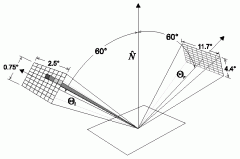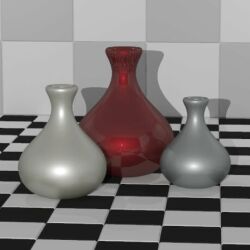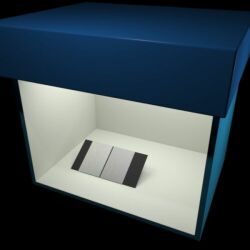|
|
Virtual
Light Meter
While it is important to be able to accurately depict
the full BRDF of a material, there is also much merit in the ability
to characterize a material with appearance attributes such as glossiness
or haziness. To this end, people in the appearance industry have sought
to develop and standardize a number of simple measurements and corresponding
measuring devices which easily and objectively quantify the reflection
properties of a surface. The result is a number of one-dimensional
scales of appearance, such as gloss and haze, and inexpensive appearance
measurement devices, such as glossmeters.
The standard specular gloss measurement defined by the American Society
for Testing and Materials (ASTM) in ASTM method D523 measures the
magnitude of light reflected in a small solid solid angle about the
specular direction. ASTM method E430 specifies that haze is a measure
of the fraction of light reflected in the off-specular direction to
that reflected in the specular direction. These well defined measurements
result in a single numerical value describing particular appearance
attributes of the measured surface. An analogous measurement may be
performed on the BRDF of a surface through computer simulation of
the measurement protocol. In this way, a simulated glossmeter or hazemeter
can be used to determine the gloss or haze of any arbitrary BRDF.
A computer program was developed which applies the measurement protocol
of many of these standardized appearance tools (eg., glossmeters and
hazemeters) to BRDFs. This new virtual light meter is essentially
a customized integration tool, using numerical quadrature of the specified
BRDF model over an adaptively subdivided source and receptor aperture
(see Figure 5 below) to compute the final standard appearance value.
In addition to being able to calculate the current standards, the
virtual light meter can be customized for other measurements. The
customizable parameters include the size and locations of the source
and receptor apertures, the specular angle, the surface orientation,
and the reflection model.
 |
|
 |
Figure 5: (left) Subdivision
of light meter apertures using the 60 degree specular gloss specifications.
The source and receptor apertures are oriented in directions  and
and  ,
60 degrees down from the surface normal, N, in the plane
of incidence. (right) Flux passing through receptor aperture due
to one source aperture subdivision. Aperture sizes are not to
scale. ,
60 degrees down from the surface normal, N, in the plane
of incidence. (right) Flux passing through receptor aperture due
to one source aperture subdivision. Aperture sizes are not to
scale. |
Standard gloss and haze values are directly dependent upon the measured
flux reflected off the surface and passing through the receptor aperture.
The integration of this flux begins by subdividing the source aperture.
For each sample point on the source, the receptor aperture is subdivided.
Based on the initial results of the integration, the receptor aperture
is adaptively subdivided until the discretely computed flux is within
some specified tolerance. Figure 5 above shows an example of the flux
due to one subdivided source element passing through the receptor.
After this flux is determined, the next source sample point is chosen
and the process is repeated. The source aperture continues to be subdivided
until a specified tolerance is achieved. Figures 6 and 7 are two renderings
of tiles with BRDF model parameters selected so as to achieve specific
gloss and haze values.
 |
| Figure 6: Rendered tiles using BRDF
models with parameters set so as to produce 20 degree specular
gloss values 80, 60, 40, and 20. |
| |
 |
| Figure 7: Rendered tiles using BRDF
models with parameters set so as to produce 2 degree haze values
10, 60, 110, and 160.
|
|



